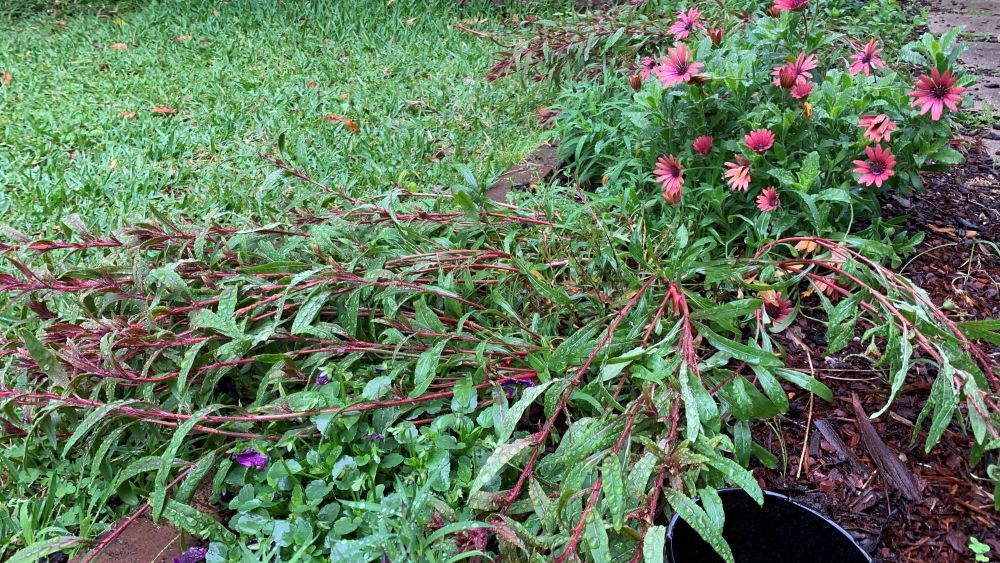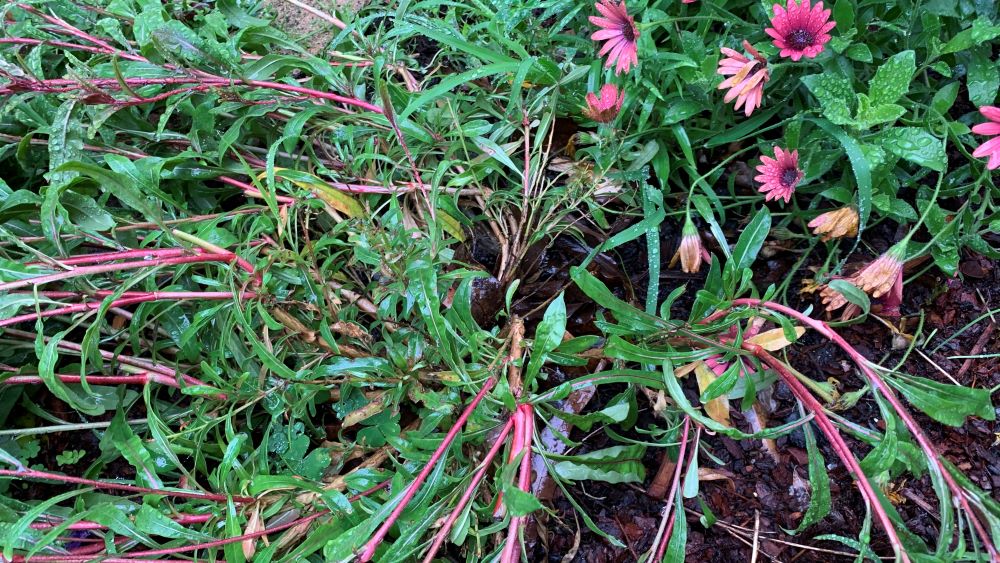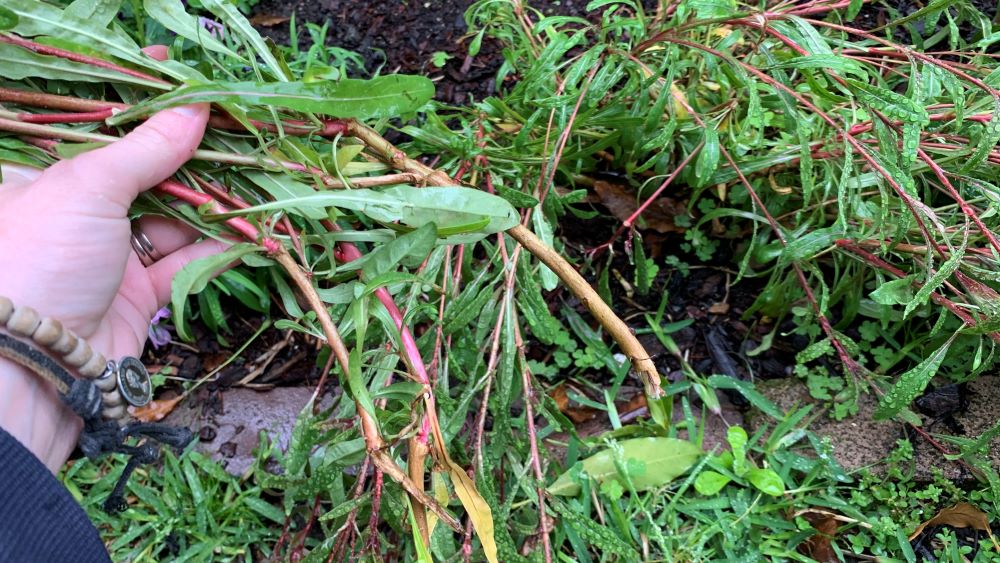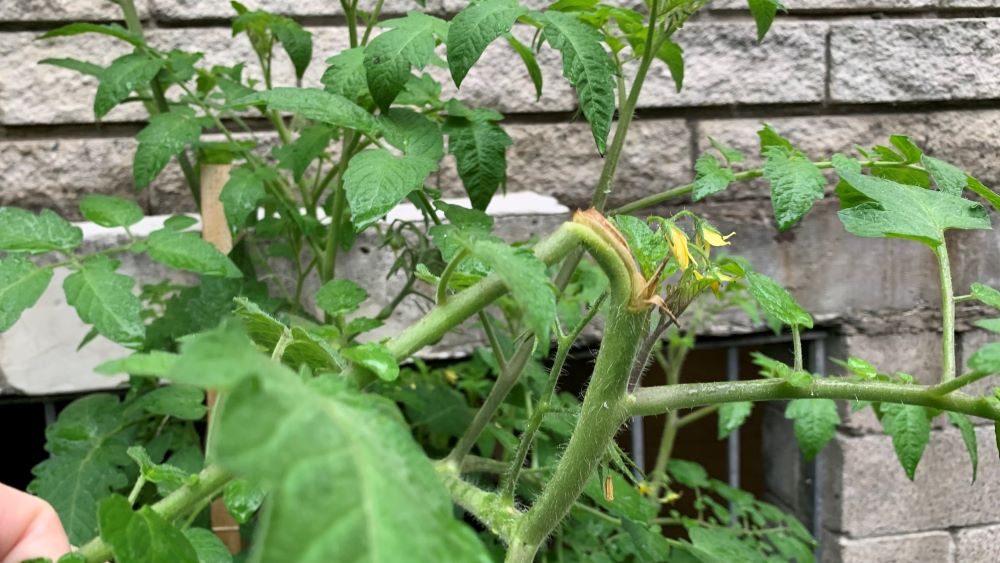Plants can droop after rain when the leaves and stems become heavy with water and can bend or break. The soil can lack oxygen after multiple days of heavy rain or the plants can suffer from rot. By mulching the plants well, trimming off long stems and adding some extra fertilizer you can save your plants.
For areas that get heavy rain you can follow some easy steps to prepare and save your plants after heavy rain.
By following the steps in this article, when the sun comes out the plant will recover quickly and stand back up straight.
We have recently had some early spring rain that has caused some of my tallest plants to droop. There are some easy ways to fix it but first, lets explore what happens to your plants after heavy rain.

What happens to plants after heavy rain
Here are the top problems caused by heavy rain that can result in drooping plants in your yard.
The soil can lack oxygen
Heavy rain can fully saturate the soil, washing small particles down into air pockets and starving the soil and plants of oxygen. After days of heavy rain the soil will be very wet in most places and will be heavy.
It might seem like a good idea to grab a fork and dig soil over to let more oxygen in but this would be a bad idea. Digging over soil and even weeding after heavy rain can actually make the soil compact more and lose more oxygen.
The best thing to do is to let the soil dry out after the rain has passed before any weeds are removed. Also wait for the soil to dry out before planting anything new. Add some compost to the soil to add more air before planting anything new.

Nutrients can be washed out
Very heavy rain can wash away water soluble nutrients in particular nitrogen. Heavy rain can wash out fertilizer, natural soil nutrients or any liquid fertilizer you might have added. Plants can droop due to a lack of nitrogen.
Heavy rain can temporarily wash away the nutrients in the soil and in the short term starve your plant of nitrogen.
This is easily fixed after the rain has passed with some slow release fertilizer like pelleted chicken manure. You can also give it a dose of fish emulsion or another organic liquid fertilizer. This will give the plant a quick burst of nitrogen to replace any that was washed away with the rain.
Just make sure the rain has passed before adding extra fertilizer otherwise it will be quickly washed away.

The plants leaves can become heavy
For tall plants with long stems they can easily droop in heavy rain. The rain drops can stick to the leaves, weighting the plant down and the leaves and stems will droop.
This happened recently after 3 days of heavy rain to my gaura plants. These are a new hybrid that are growing large, long stems which have been weighed down with the recent rain. Some of the long stems broke as they were dragged down by the weight of the rain.

Stems can break
One of the problems of heavy rain on plants is that it can weigh down the stems and they can break. This could happen to any plant that has a delicate stem like gaura, tomatoes and daisy plants.
Tomatoes can be saved from this by tying them to a stake before the rain. This will hold up the heavy stems and prevent them from bedding and breaking with the weight of the rain.

Rot, mold and fungus
Heavy rain can cause mold, rot and fungal infections which can cause the plants to wilt after a few days. This can occur a few days or up to a week after the rain has occurred. As excess water stays in the ground, it can cause fungal infections on the roots, stems or leaves.
You may notice white or black mold on the leaves or stems or even notice mold growing on the mulch underneath the plants. For plants affected by mold or fungus on their leaves I like to trim and remove the leaves before they infect the rest of the plant.
Removing the affected areas is usually enough to stop the spread if the rain has stopped. A fungicide might be needed if the fungus cannot be fully removed by taking off leaves.
Mushrooms can grow in the mulch around your plants after heavy rain but these wont’ cause any harm to your plants. You can remove them if you want but they usually die off on their own when the weather warms.

How to prevent plant damage from heavy rain
Here are my top tips for preventing plant damage from heavy rain in your yard.
Prune back long stems
The first step to prevent plant damage in long rain is to remove any long stems that could break when they are weighed down. You can remove the top few inches to keep the stem light so it will carry less water. This can prevent stem breakage.
Shaking off the rain from the stems after it has finished can help to lighten up the stem. You will notice that the stems will stand up quicker. Take care when you do this though as it is easy to break delicate stems.
Stem length can be removed before or after rain but doing it before rain hits can prevent stem breakage.

Add lots of mulch
The next step to prevent damage to plants during heavy rain is to mulch them well. This will prevent soil run off, can absorb extra water and prevent the soil from becoming soggy. I like to use 3 inched of bark mulch on my soil as this has the best water holding capacity of all of the mulch types.
Add some liquid or slow release fertilizer
The next step after the rain has passed is to replace any nutrients lost. Pelleted chicken manure is a mild, nitrogen fertilizer that can replace lost nutrients over 6 weeks.
Add pelleted chicken manure again after 6 weeks in spring to encourage more leaf growth. These tips will help to prevent damage to your plants during heavy rain and prevent breakage, mold fungus and rot.
Why plants droop after heavy rain | Summary
Plants can droop after heavy rain due to the weight of the rain pulling down the stems and breaking them. Droop can also occur due to a lack of nutrients, compaction of the soil or fungal infection. Remove any damaged stems, add more mulch to absorb extra water and add a slow release fertilizer.
These tips will help your plants to recover after heavy rain.
Happy growing.
I am an accredited practicing dietitian, experienced gardener and a dedicated cook. I love writing and sharing my experience so you can learn from my successes and mistakes.
